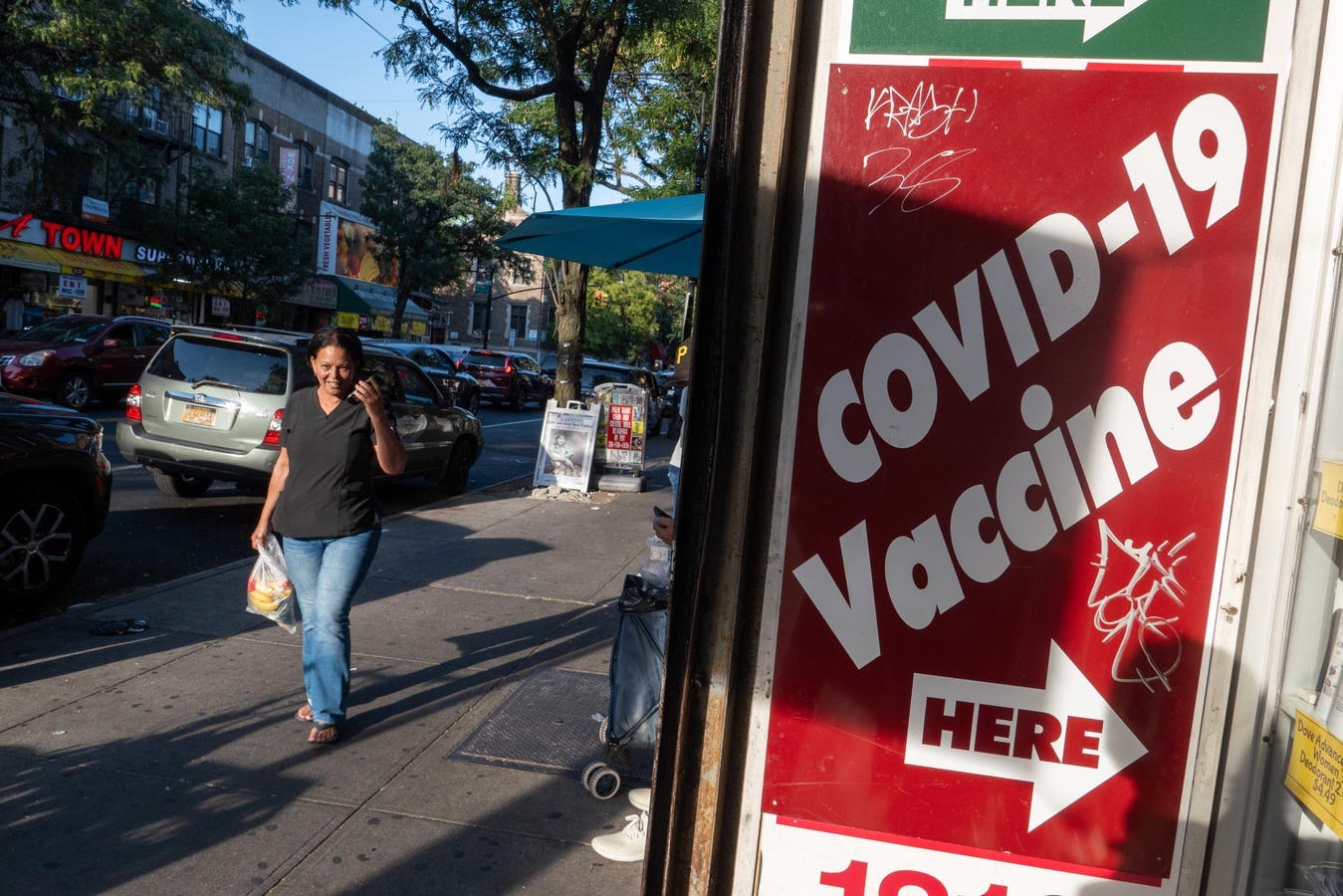Staying up-to-date on your COVID-19 vaccinations seems to have gotten a whole lot harder for many over the past several months due to actions taken or not taken by the Trump administration.. (Photo by Spencer Platt/Getty Images)
Getty Images
Finding where and how to get vaccinated shouldn’t be like Finding Nemo. But staying up-to-date on your COVID-19 vaccinations may have gotten a whole lot harder for many people over the past several months due to actions taken—or not taken—by the Trump administration. So, here’s what you can do to get the COVID-19 vaccine and maximize your protection in general against stuff like long COVID, being hospitalized, dying and stuff like that.
There Is An Updated COVID-19 Vaccine
Staying up-to-date on COVID-19 vaccination means accounting for two things. One is the fact that immune protection against the COVID-19 from either getting vaccinated or infected by the severe acute respiratory syndrome coronavirus 2 starts waning at the four-to-six month mark. The other is that the SARS-CoV-2 mutates about as often as the Kardashians change outfits. This means that if the last time you got vaccinated was over a half-year ago, you don’t have the latest and greatest protection.
Therefore, as has happened the past few late Summers and early Autumns, both Pfizer/BioNTech and Moderna have gotten updated versions of their COVID-19 vaccines approved by the U.S. Food and Drug Administration for 2025. These updated vaccines target the LP.8.1 variant of the SARS-CoV-2 as opposed to the vaccines that came out in 2024 and targeted the KP.2-variant. That means the mRNA in the vaccines will prompt your cells to produce the spike proteins that line the surface of the LP.8.1 variants.
Now, LP.8.1 may sound like something a record player would use. But it’s the name of the variant that stood as the dominant big dog during much of the early Spring 2025, as I described previously in Forbes. Other variants like NB.1.8.1 have subsequently tossed the LP.8.1 aside like leopard prints. That means the updated COVID-19 vaccines won’t be specifically targeting the latest and greatest variant. However, the LP.8.1-targetted vaccine will still be a whole lot closer than the KP.2 one.
Plus, that whole waning immunity thing means that your immune system needs to be periodically reminded that the SARS-Cov-2 is a bad thing. When it comes to this virus, your immune system is a bit like that person who keeps forgetting how bad his or her ex was until getting back together again. Therefore, a reminder, any reminder of the SARS-CoV-2 spike protein at least every year or so, could keep your immune system more attuned.
Challenge One: The FDA Has Significantly Restricted Eligibility For The COVID-19 Vaccine
But will the actions of the Trump administration make it harder for you to give your immune system this reminder? For example, when the FDA approved these latest versions of the COVID-19 vaccines, the FDA did not approve them for everyone six months and older as it’s done in the past. Instead, under Marty Makary, MD, the FDA Commissioner appointed by the Trump administration, the FDA has restricted the approval the updated vaccines to just those either 65 years and older or those with chronic medical conditions.
So, if you are 64 years, 364 days, 23 hours and 59 minutes of age or younger and want the COVID-19 vaccine, you may have to provide evidence that you’ve got some kind of chronic condition that makes you even more susceptible to having bad outcomes from COVID-19. Possibilities include having asthma, cancer, cerebrovascular disease, chronic kidney disease, chronic lung disease, chronic liver disease, diabetes, heart conditions, HIV, neurologic issues, obesity or an immune system disorder. That may mean getting a note or prescription from your doctor because telling the pharmacist or whoever will be giving you the vaccine, “Umm, I’ve gotten the COVID-19 vaccine like every year since 2021” may not be enough.
Challenge Two: The CDC Has Not Yet Issued Guidance About The COVID-19 Vaccine
Another issue is the Centers for Disease Control and Prevention, where things seem a little out of control right now. Over the past eight months or so, the Trump Administration has laid off or RIFd over 2,000 CDC employees. A number of leaders within CDC have also resigned. And the CDC currently has no real established leader since the Director who was confirmed by the Senate in July, Susan Monarez, PhD, was sort of fired by the Trump Administration sometime around August 27, 2025, after only about a month on the job. At this point, the CDC is being run by an acting director, Jim O’Neill, who is neither a scientist nor a health or public health professional.
Plus, the external body that’s supposed to advise the CDC on COVID-19 vaccine matters, the Advisory Committee for Immunization Practices or ACIP, hasn’t really done that yet. U.S. Health and Human Services Secretary Robert F. Kennedy, Jr. dismissed all standing members of the ACIP and replaced them with people he chose. The ACIP has typically met within days of the FDA approving a new COVID-19 vaccine to provide guidance on what the CDC guidance should be. But the ACIP is not meeting until September 18 to 19.
Some states like California and New York state have gone ahead and issued their own guidance about COVID-19 vaccines. But at least 18 states, including Colorado, Connecticut, Georgia, Iowa, Maine, North Carolina, Pennsylvania, Virginia and West Virginia, typically wait to follow CDC recommendations when it comes to indicating what pharmacies should dispense. Therefore, if you are in one of these 18 or so states and want a COVID-19 vaccine, you may find your pharmacy requesting a prescription from doctor, even if you are 65 years and older.
Challenge Three: It’s Not Clear Whether Insurance May Cover The COVID-19 Vaccines
Then there’s the issue of paying for the COVID-19 vaccine. As I’ve covered before in Forbes, Pfizer and Moderna, surprise, surprise, really hiked up the prices of their COVID-19 vaccines as soon as the federal government stopped paying for them. Therefore, many people have had to rely on insurance companies or Medicare to offset the costs of these vaccines. Federal law has required most insurers to cover any vaccines recommended by the CDC’s ACIP. But, and that’s a big but I cannot lie, with the ACIP not meeting yet and the CDC not specifically recommending the updated COVID-19 vaccines yet, it’s unclear which insurers will cover what.
Getting The COVID-19 Vaccine In October Would Offer Protection Against The Yearly November COVID Surge
All of these challenges sit right ahead of the most important time of the year to get a COVID-19 vaccine if you are going to get one. Every year since 2020, there’s been a Winter COVID-19 surge starting sometime in November. So, assuming that it takes about two weeks after getting vaccinated for your immune system to say, “Oh, yes, this spike protein is not a good thing” and rev up its protection, getting vaccinated in mid-to-late October would help offer maximal protection for the next anticipated COVID-19 surge.
How Then Do You Get The COVID-19 Vaccine?
If you want to get the updated COVID-19 vaccine and spare yourself aggravation, the best thing to do is preemptively contact your doctor or local health department. They can then clarify what you need to do to get vaccinated. They also may be able to get you the necessary prescriptions or documentations. Since things are a bit chaotic in public health with all the layoffs, cuts and misinformation and disinformation floating around, what you need to do can vary significantly from location to location. Therefore, don’t assume what’s happening in other places to apply to your specific locale.
Don’t Just Rely On The COVID-19 Vaccine For Protection
Another thing to keep in mind is getting vaccinated against COVID-19 has never been the one and only thing to do to protect yourself. As I have emphasized previously, the COVID-19 vaccine is not like a gigantic, concrete, full-body condom. It will not offer your 100% protection. It will not really keep you from getting infected. What it mainly does is reduce your risk of getting worse outcomes if you do get infected. And this isn’t 100% either.
Therefore, it is better to treat the COVID-19 vaccine like a slice of Swiss Cheese, using the analogy advanced by Ian M. Mackay, PhD, a scientist and an adjunct Associate Professor at the University of Queensland, during the pandemic, as I mentioned before in Forbes, The COVID-19 vaccine has got its weaknesses, its gaps, its holes. And in general you want to keep your holes covered up well. So, rather than relying on a single intervention, layer on several interventions such as keeping your surroundings well-ventilated with purified air, wearing a good quality face mask when indoors in close quarters with others, washing your hands frequently and thoroughly, keeping high-touch surfaces clean and disinfected, keeping a reasonable distance from others and staying up-to-date on vaccination.









